Welcome to my Editing Portfolio!
I worked really hard all semester on each of my projects. I learned quite a lot about editing for publication, placement, and how to make things look good to the reader!
Enjoy!

Welcome to my Editing Portfolio!
I worked really hard all semester on each of my projects. I learned quite a lot about editing for publication, placement, and how to make things look good to the reader!
Enjoy!
Many people believe editors are nothing more than people behind desks who sign paychecks and make sure the author is happy. The editor has far more responsibilities than making the clients happy. Editors occupy different fields of study, and all of them are important. Newspapers, magazines, the textbook and the literary fields are just a few jobs where editors and writers must work extensively to make sure the reader is satisfied.
Most importantly, an editor is management. They must ensure that all projects under their care are on point. According to the International Institute for Sustainable Development (IISD), the editor plays a key role in internal capacity building and the evolution and implementation of a style manual. A managing editor manages the staff, sets and enforces policies, determines coverage, and is a liaison between the editorial staff and the publisher and editor-in-chief.
As a manager of the staff, an editor must oversee all other editors and act as a mentor and guide. Ron White from the Global Post says the managing editor works closely with the opinion page, news, sports, lifestyle, graphics, online, and design editors as well as all other top newsroom employees. Within smaller companies, this editor may hire and fire editorial employees, which includes reporters and photographers.
As an editor, determining coverage is very important in the news and magazine media. This means that they assign stories to news departments or to journalists directly. They approve or deny pitches and feature stories. White says editors play an advisory role in deciding how stories are reported with recommendations where a story should be featured on any given page. An editor determining coverage must also oversee compliance with style standards – meaning they make sure all editors and reporters under them use the correct fonts and in-house punctuation, spelling, and grammar standards. They also make decisions about adjusting deadlines under special circumstances, especially during times of elections. They must also make the tough call to run controversial content. These responsibilities are often associated mainly with newspaper editors.
Editors in the publication world have the added responsibility of protecting the writer from some of the harshest commercial winds and helping them achieve greatness. A huge part of the publication editor’s job is to read a book in its entirety and pick apart sentences, scenes, and syntax. According to novelist Eleanor Catton, “an editor [is like] a butcher…only a butcher can turn a live, stamping, snorting, animal into something you can stomach.” They are also a midwife, a parent, a nanny, a matron, a therapist, a conspirator, and a friend. Editors are tasked with giving a bird’s eye view of the projects they are overseeing and managing. The editor must be in constant communication with their writers. They must collaborate and compromise to make sure all projects are running smoothly.
The roles of the editor is numerous. Among them are smaller responsibilities that add up to the very important job an editor must accomplish each and every day. These little tasks, according to IISD, include: substantive editing, stylistic editing, copy editing, image sourcing n management, fact checking, proofreading, and approval. They must coach their writers into getting the job done and completed by deadline. If some of these tasks are unable or unsuitable to the job description of the editor, then the editor will delegate any and all tasks to those more qualified to complete them. The editor, in turn, will make sure the tasks are actually completed.
The end result and the reader reactions are the most important aspects of the publication editor. Obtaining the best possible version of the truth and delivering it to the public is very important for the newspaper and magazine editors. Each output, according to IISD, presents unique challenges and thus require unique solutions. An evaluation session after each project helps ensure everyone is on the same page in regards to results. The goal of these sessions is to discuss strengths and weaknesses and to make changes to the process and execution of projects. No one kind of editor is more important than another. The literary, textbook, magazine, and news media (among others) would not run as smoothly without editors.
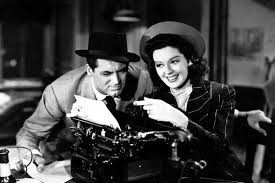
Photo Credit, Google Images. One of television’s most popular editors is Cary Grant’s character Walter Burns in His Girl Friday, with his quick wit and charismatic personality. He plays opposite the lovely Rosalind Russell (character Hildy Johnson).
~~~~~~~~~~~~~~~~~~~~~~~~~~~~~~~~~~~~~~~~~~~~~~~~~
Sources Used:
http://www.iisd.org/sdcn/webworks/writing/roles.htm
http://www.theguardian.com/books/booksblog/2014/mar/12/writers-editors-eleanor-catton-booker-winner
http://everydaylife.globalpost.com/duties-managing-editor-1775.html
~~~~~~~~~~~~~~~~~~~~~~~~~~~~~~~~~~~~~~~~~~~~~~~~~
Writing a news story is quite different than writing other types of articles. It is even different than writing feature stories. According to WikiHow, news articles present information in a specific way to convey all the important information. The challenge is presenting the information within a limited word count. Knowing how to write news stories is beneficial to a journalism career as it can exercise writing skills and help aid in the ability to convey information clearly and concisely.
As with a feature story, there are at least eight steps in writing a good news story. First, a decent place to start is compiling all the facts. An outline or list can help keep a news writer organized and helps prevent the writer from leaving out any important and relevant information. If a news story is not organized properly, a reader can get caught up in trivial background information instead of reading the facts pertaining to the important event first. Following the second step is imperative. A news story must have a captivating leading sentence. It is one of the biggest parts of the article and should completely but simply state the topic of the article.
Give all important details. This step includes all relevant details that relate to the leading sentence. Details must also include information on what happened, setting, and who was involved. Mediacollege dot com puts the focus for this particular step on a writing method that is taught since grade school. This sometimes goes by the Five “W”s and the “H” method. A news writer must piece together the who, what, where, when and why details of the story as well as the how. Without these six factors, a news article would be filled with fluff and non-relevant information to the event being written about. A good rule of thumb would be to get these questions answered as soon as possible within the story. That way the reader gets all the information he or she needs to be informed about a situation. If they decide to read on to get any background information included, they can do so without having to decipher what is or is not important.
Background information would be step four of how to write a news story. Follow up facts with additional information that allows readers to learn more. This information could include details such as contact information, quotes from interviews and even additional facts about the people involved and the topic being reported on. Facts should always be checked before concluding the article. This step (step five) is imperative. A news writer does not want to include any misguided information like names or dates or contact information. Step six is all about remaining unbiased. News is news. Sure, there are more than one sides to a story, but fact is fact, and objectivity is needed in making sure the articles uphold the factual necessity. All that’s left is to conclude (step seven) by restating the leading statement and rereading for any other errors before sending the article off to the editors (step eight).
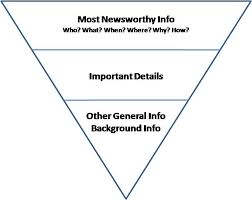
Photo Credit, Google Images. The Inverted Pyramid explains the importance of information as it is classically written in a newspaper.
There are quite a few writing “do not’s” when writing a news story. Scholastic lists some of these rules. A few of these include not starting a sentence with the person or title of a person or company. Action should come first and then the name. Do not start a lead with details of day, date or time, especially if it is not current information. Also, avoid using too many conjunction sentences. Break sentences into structures with shorter, more direct focus. Write all sentences as “subject, verb, object” sentences.
~~~~~~~~~~~~~~~~~~~~~~~~~~~~~~~~~~~~~~~~~~~~~~~~
Sources Used:
http://www.wikihow.com/Write-a-News-Article
http://www.scholastic.com/browse/article.jsp?id=3746606
http://www.mediacollege.com/journalism/news/write-stories.html
https://www.embl.de/aboutus/communication_outreach/writing_news_story.pdf
~~~~~~~~~~~~~~~~~~~~~~~~~~~~~~~~~~~~~~~~~~~~~~~~~
In order to write an effective feature story, a person must know the definitions of a feature story. Dr. Anthony Curtis of the University of North Carolina at Pembroke explains the background of what a feature story should be define as on his webpage. First, they are human-interest articles that focus on any particular persons or events. They can also be about a location. These stories are journalistic. This means that the subject is researched, described, and the article is colorful, well-thought, reflective and includes comprehensive writing focusing on original ideas. Topics are researched in depth and the resulting articles explain the more interesting aspects of the story rather than surface details. Overall, feature stories are popular content within newspapers and magazines. They are also quite popular within the blogging community, websites, television broadcast, and among other mass media.
Feature stories are quite special in that they are allotted a lot more room via preparation and copy length. Journalists who report on late-breaking hard news are not afforded these luxuries. It must be said that there are different feature stories that can be written. These types include: human interest, profiles, how-to rundowns, historical features, seasonal themes, and behind the scenes. All feature stories are considered nonfiction because they are journalistic reports and are not given the kind of freedom opinion essays or editorials are allowed. However, a certain creative freedom must be responsibly used when writing.
Writing a feature story may be considered easy to write by some people. But there are a few steps that must be remembered and followed in order for the story to read well and keep readers enticed while being truthful and factual. There are at least 8 steps. WikiHow explains these steps quite efficiently. First, a story must be found. A feature writer must not just look for a story that interests them, but also what people are talking about, are, and have been. One way to find a story is to pay great attention to the news. What is popular? Many feature stories are found because the question “why” is asked about an incident that has occurred. Second, research must be conducted. Gathering information is very, very important in making sure all facts necessary to the story being written are being presented. This can be done from interviewing sources or reviewing material that has been previously published.
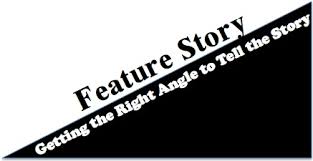
Photo Credit, Google Images. It is important to make sure a reporter finds the right angle that will sell the story, keep the news alive, and tell the story truthfully.
The third step deals with deciding on what type of feature story to write. The most common type is human interest. That decided, step four is all about organization. Think of a play. It is separated into acts that keep the action well-organized and the reader enticed. Like any written piece, an introduction to the featured subject must be captivating keep a reader interested. Just like any other written piece, a body and a conclusion follow, leading into step five. Style should be applied to the feature article. A feature writer should consider whether his or her story comes across literary, chatty, humorous, or serious. Make sure paragraphs are short and witty enough so a reader doesn’t get lost in the words and lose interest. A certain variety in sentence structure should be applied as well.
Step six and seven deal with adding just enough fluff so the article is still fully factual, but added details still continue to keep readers interested. These steps also deal with creating a title that communicate what the story is about and adds even more interest. The title is the most important aspect in a story to catch the attention of the reader. It is the job of the rest of the article to keep the interest. Finally, step eight is all about polishing. Check spelling and grammar. Reread the article again to see if anything can be added or taken out. Make sure all information is correct and quoted correctly. If possible, try not to write anything that is overly offensive. All that is left is sending in the article to an editor to make sure everything is in order.
~~~~~~~~~~~~~~~~~~~~~~~~~~~~~~~~~~~~~~~~~~~~~~~~~
Sources Used:
http://www2.uncp.edu/home/acurtis/Courses/ResourcesForCourses/WritingFeatureStories.html
http://www.wikihow.com/Write-a-Feature-Article
~~~~~~~~~~~~~~~~~~~~~~~~~~~~~~~~~~~~~~~~~~~~~~~~
This poster was inspired by one of the greatest novels of all time, Stardust, by Neil Gaiman. It is bright and colorful. I am proud of this poster, and with the skills I learned doing this assignment, I have the capability to make posters and fliers
This typography poster is focused on the typography, using type to get my messages across (with the aid from the photo behind the fonts). It was created through InDesign. Enjoy!

Photo Credit, Google Images. Page One: Inside the New York Times is a documentary that takes you inside the most popular newspaper in America.
What a powerful, informative documentary. Page One: Inside the New York Times really delves into the topic of media producing news. Growing up, I have never been one to run for the newspaper. In fact, the only section I ever wanted to look at was the comics section of my local paper. Any news I would catch a glimpse of would be from the nightly news before dinner. College forced me to broaden my horizon. I took a political science class that made me look into and research current events. I became fascinated with the news. I couldn’t get enough of making sure I was up to date on current events – especially because it was a major election year. And then that semester was over and I was more interested in finishing my Associate’ degree.
Now, I am being a bit more cautious of what is going on. I love books, and I feel at home in bookstores. But the print world is digital now, and it is becoming rare for a person to walk round with a hard-or-paperback book in their hands. It is becoming the same within the news media. So much is digital that all people need to do is go onto the internet on whatever digital device is handy and look up news. Facebook and Twitter give quick links to the news, where more links await the attention of the world.
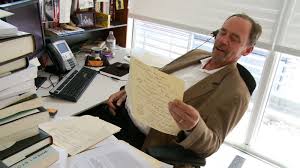
Photo Credit, Google Images. In the documentary, David Carr, a reporter for the New York Times, consults one of his sources on the phone.
Page One: Inside the New York Times highlights this change in reporting quite well. By taking us behind the scenes, we can see a first-hand look at the struggles that newspapers and magazines are facing. The entire documentary was fascinating – the interviews, the meetings, the research…everything is important to making sure the people have the news they need to make free and self-governing decisions. This is the first priority of journalism. But now, everyone believes they can be a reporter. All they need to do is have their video cameras and phones ready to capture what is going on. Apparently, we are all reporters, and with the help of social media and the rest of the inter-web, anything can be considered “news”.
I have a feeling that in the years to come, I will be going back to this movie to remind myself that there is an art and a sophistication in the practice of journalism. There is an art and sophistication in holding a print newspaper in your hands, turning the pages and smudging the ink with your fingers. Sure, it isn’t as convenient to carry as your phone, but it is still reliable and it is a tradition.
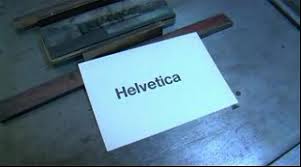
Photo Credit, Google Images. Helvetica is a documentary about the type font that has taken the world by storm.
Helvetica is a film that should be watched more than once. The reason for this is not because it is just dreadfully boring at first. I had to watch it twice because I couldn’t get through it once. I had to force myself to sit and stare at the screen, headphones on to block out the rest of the world. Then I realized something. Helvetica is not a half bad film. I didn’t give it a chance. I was letting other people’s opinions rule my view. The movie itself was long and tiresome and, yes, boring. However, the enthusiasm of the cast was brilliant, if not over-the-top.
As a documentary, Helvetica was well done. As a documentary about type, it was good. I had no idea that the Helvetica typeface was so important. In school, we are taught to use Times New Roman for all essays and homework assignments. It is the only type I have ever consistently and constantly used. It came to the point that I always believed it to be that way for everyone for everything. I experimented with other fonts growing up for various projects for school, but I have never actually used Helvetica.
The history that encompasses the Helvetica typeface is quite rich and interesting. It was a font invented for the purpose of updating an old German sans-serif typeface. It is a polished, clean, and versatile type, one that can be (and is) used for many purposes. What I find fascinating is that Helvetica is not even found on my Microsoft Word application. For such a well-known and well-used type, shouldn’t it be accessible to everyone?
The movie certainly opened my eyes about the use of type and typography. It is a form of art that so few can master. From the documentary, I believe only a select few have the right eye for creating font over the years. I would like to thank them, for without font, I would not be able to do this assignment on the computer. I would not be able to read books. Without font, the world would be so dull and slow and not efficient in any way.